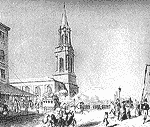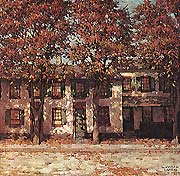|
Building first starts in the Toronto area for military reasons.
In 1720 the French found Fort Toronto also known as Fort Rouille.
The first Toronto home is recorded in 1791 a small log cabin
on the bank of the Humber. It belongs to translator and Fur
Trader Jean
Rousseau . By 1973 the British build Fort York, and the
town is officially christened by Lt.
Governor Simcoe. The next year, 241 people live in York
and the foundation of a town is beginning.
At the beginning of the 19th century, construction is driven by defensive, religious and government forces. A jail is built in 1798. Yonge street is laid out, St. James Church begun, and the first grammar school erected. In 1803 public land is allocated for St. Lawrence Market and limestone is first used for the lighthouse on Gibraltar Point. Lucky really, because the invading Americans in the War of 1812 burn down many wooden structures.
 |
St. James Cathedral, 1848,
By Sir Sanford Fleming |
With the post-war ascendancy of the Family Compact, grand homes are built by the powerful, like D'arcy Boulton's Grange, behind the present day Art Gallery of Ontario. York's first Civic Square is built in 1829; the jail, courthouse and Legislature cluster where Roy Thompson Hall is today. King and Yonge is the commercial strip in the 1820s, and Toronto General Hospital and the Bank of Upper Canada are soon erected.
Slums first appear northwest of Queen Street in 1833, a result of unprecedented immigration. Named St. John's Ward, it will fester as a receiving area for poor immigrants well into the 20th century. While immigrant neighbourhoods eventually move west, along with business, the inner city remains neglected. Not even the make-work dollars of the Depression trickle into the area. WWII veterans return to a housing crisis. In 1948 work begins on Canada's first low cost housing complex, Regent Park.
 |
|
Casa Loma, 1914 |
But architecture detail comes slowly to Toronto. Midway through the 1800s, Toronto's growing wealth and confidence begins expressing itself architecturally: King's College, St. Lawrence Hall, The Bank of Toronto, the Queen's Hotel add elegance to the landscape. Architect E. J. Lennox designs Old City Hall and will later erect Sir Henry Pellat's Casa Loma. Richard Waite designs Queen's Park in grand Romanesque style. Eaton's, in a new 3-storey department store, is a modern marvel with its electricity and fire sprinklers in 1893.
But behind the beautiful facades, lie the sweatshops and fire traps of the industrial age. Thousands of workers toil in heat, cold and light-less rooms. The Great Fire of 1904 ravages Toronto's commercial centre. Fourteen acres are flattened, causing $13 million in damage. Out of the rubble emerges a more beautiful, fire proofed city. Construction jumps 448% in 1905 - there isn't enough manpower in Ontario to meet the needs of Toronto's growth.
 |
|
Toronto Fire, 1904 |
Twentieth century architecture pays homage to civic pride: The Art Gallery of Ontario, the ROM, Winter Garden, Royal Alex, Royal York, and Union Station are all born in grand style. In 1931, the Commerce Bank Building is the tallest building in the Empire - 25 storeys!
Post War Toronto loses to the suburbs as vets and new families move out of town. Don Mills is Canada's first planned suburb and heralds the baby boom. Then Metro Toronto is formed, the 1st metropolis in North America. But in 1954, Hurricane Hazel rips through the city, killing 81 people and causing $25 million in damages.
 |
|
Houses, Richmond Street, 1911 by Lauren Harris |
Toronto's architecture in the last half of the 20th century reflects a big, bold homage to art, commerce and government: the $12 million O'Keefe Centre (1960), TD Centre (1968), CN Tower (1976), Eaton Centre (1978), Roy Thompson Hall (1982), and the massive, $585 million Sky Dome. (1996)
Urban renewal and modern development takes off in the 1950s and 60s. Traffic is diverted to the Gardner Expressway, hanging over Fort York like a shadow. Citizens worry about congestion and density; about development squeezing out downtown communities. A series of reform mayors, including David Crombie and John Sewell, bring in policies to safeguard the livability of the downtown core.
Toronto withstands the urban decay of other North American cities. Unlike their American counterpart, Canadian banks don't abandon city neighbourhoods by withholding mortgages. Financial tourniquets aren't applied to old or modest communities; they're allowed to flourish. Racial ghettoes don't appear, avoiding property de-valuation and the flight of affluence, so apparent in American cities. Another blessing is the lack of federal funding for highways, which could have devastated the city. Except for the TransCanada, highways are financed by municipalities and provinces, which allow citizens a more direct way to determine routes. Finally, Toronto's urban renewal schemes are less destructive, and low cost housing blocks aren't erected in the downtown core.
Next: Education
|
